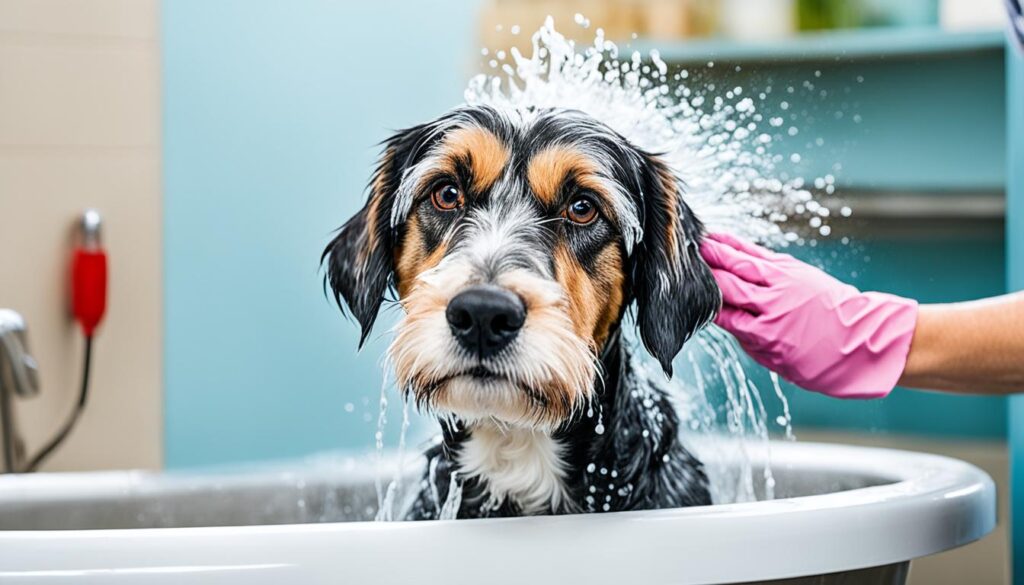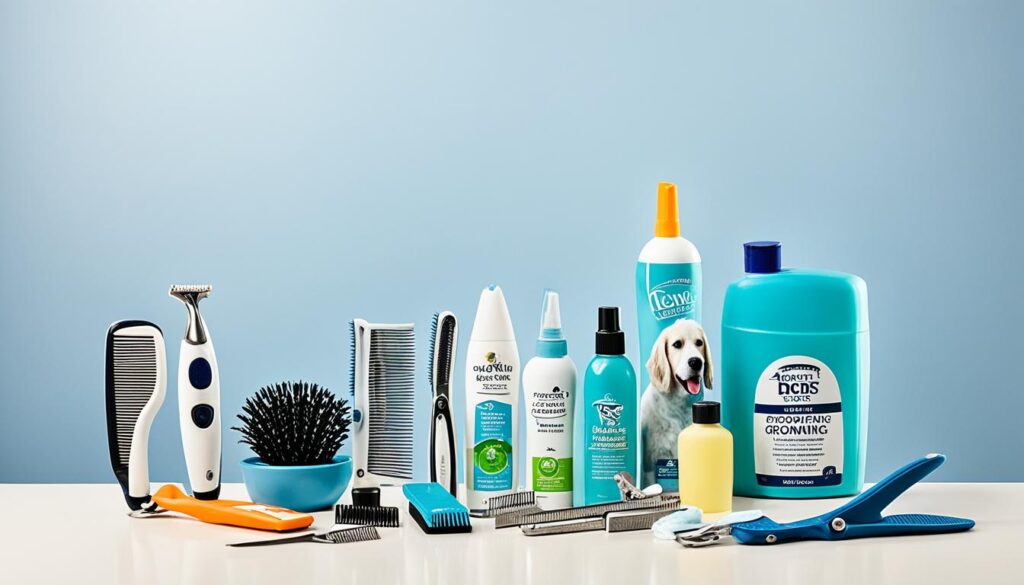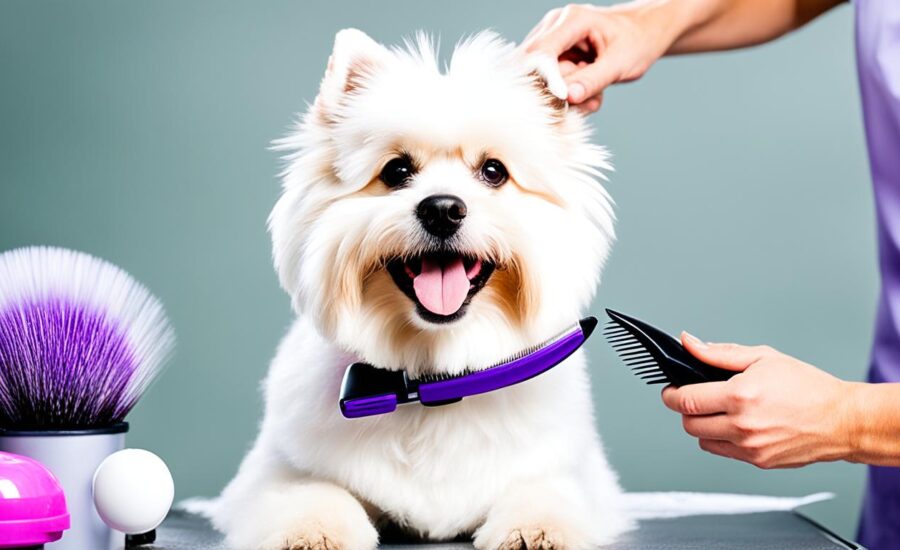We all love our pets and want the best for them. But, sometimes we make mistakes during grooming without knowing. Mistakes like using the wrong products or not grooming often can hurt our pets. By learning the right grooming tips, we can keep them looking and feeling great.
Key Takeaways:
- Recognizing common grooming mistakes can help in avoiding preventable health conditions.
- Regular grooming sessions are crucial for early detection of skin conditions or parasitic infestations.
- Choosing the correct grooming tools and products is essential for your pet’s health and comfort.
- Dental care and nail trimming are vital grooming aspects that impact overall pet health.
- Awareness of proper grooming frequency and techniques can elevate pet welfare significantly.
The Importance of Understanding Pet Grooming Essentials
Learning about pet grooming is key to keeping your pets healthy and happy. When you use best practices for pet grooming, you do more than make them look good. Good grooming also means a healthy life for your pets.
Comprehensive Grooming Goes Beyond Aesthetics
Grooming is about more than just looks. It helps with health issues, like reducing shedding through regular brushing. This avoids matting, which can be painful and cause skin problems. Be careful to avoid pet grooming mistakes that lead to harmful pet grooming habits. This includes not brushing the undercoat or using the wrong tools that can hurt your pet’s skin.
Identifying Potential Health Issues During Grooming
Grooming time is a chance to find early signs of health problems. Look for redness, lumps, or bugs in your pet’s coat, which could mean they need a vet. Regular grooming finds issues early, preventing serious problems. Grooming also includes taking care of their teeth, ears, and nails to keep your pet healthy and happy.
Grooming is important for more than just keeping your pet clean. It’s a vital part of care that impacts their health. Let’s look at important grooming tasks and common mistakes to avoid.
| Grooming Task | Health Benefit | Common Mistake |
|---|---|---|
| Brushing | Prevents matting and skin irritation | Ignoring the undercoat |
| Dental Care | Prevents gum disease and tooth decay | Not brushing regularly |
| Ear Cleaning | Helps avoid infections | Using cotton swabs which can damage inner ear |
| Nail Trimming | Prevents joint pain and posture issues | Trimming too close to the quick |
With careful grooming, you can keep your pet from many health issues. This makes sure they both look and feel great.
10 Grooming Mistakes That Can Harm Your Pet’s Health
Knowing the grooming tips for pet owners is key to prevent pet health risks. Many common mistakes can cause discomfort or illness during grooming. Let’s look at these areas to keep your pets both happy and safe.
Infrequent Grooming: Matting and Skin Issues
Not grooming your pet often can lead to health issues. A regular grooming schedule helps avoid these problems. Lack of grooming can cause matting and skin infections.
Improper Bathing Techniques: Stripping Natural Oils
Washing your pet is about more than just cleanliness. If you use harsh products or the wrong way, you can strip their coat of essential oils. This leads to a dull coat and irritated skin.

Neglecting Oral Care: Leading to Dental Diseases
Not focusing on dental care is a big grooming mistake. By regularly brushing their teeth and getting check-ups, you can prevent gum disease and tooth decay. Pets need dental care just like we do to avoid serious health problems.
Ignoring Signs of Skin and Coat Problems
Watch for unusual signs in your pet’s skin and coat during grooming. Look out for hair loss, bumps, or parasites. Addressing these signs quickly can improve your pet’s health greatly.
Hazardous Ear Cleaning Practices
Ear cleaning requires care because a pet’s ears are delicate. The key is to be gentle and use the right tools. This prevents injuries and infections.
Incautious Nail Trimming: Joint Pain and Injuries
Nail trimming is important in grooming. If not done right, it can cause pain or injuries. Trim nails correctly to keep your pet’s paws and joints healthy.
Avoiding these grooming errors can make grooming smoother and keep your pet healthy. Regular, careful grooming is part of caring for your pet properly.
Critical Grooming Tools and Their Proper Use
It’s key to follow best practices for pet grooming for your pet’s health. Knowing which tools fit your pet’s coat type and using them right is vital. Choosing the correct tools and using them right helps avoid pet grooming mistakes.
For example, long-haired pets need slicker brushes for detangling. Short-haired pets benefit from a rubber curry brush’s gentle massage. These details are crucial for pet owners. Below is a table listing the tools you need for good grooming practices.
| Tool Type | Suitable For | Purpose | Usage Tips |
|---|---|---|---|
| Slicker Brush | Long-haired breeds | Detangling and removing loose fur | Use gentle strokes to avoid skin irritation. |
| Rubber Curry Brush | Short-haired breeds | Massaging skin and removing dead hair | Employ circular motions for an effective and soothing experience. |
| Nail Clippers | All breeds | Trimming nails to a safe length | Trim nails gradually to avoid cutting the quick and causing bleeding. |
| Thinning Shears | Breeds with thick coats | Thinning fur without changing the overall shape | Focus on overly thick or matted areas to maintain an even coat. |
Dull clippers or shears can be harmful. They may cause cuts, skin irritation, or worse. So, it’s essential to keep your grooming tools sharp for a safe grooming time.
Grooming advice often includes learning new techniques. Each pet has different needs that are important to consider. Taking care of your grooming tools shows care for your pets.

Understanding Your Pet’s Unique Grooming Needs
Every pet has its own unique charm and needs a special grooming approach. It’s not just about avoiding mistakes; it’s doing what’s best for your beloved pet. Making sure your grooming fits their needs is key for their look and health.
Choosing the Right Grooming Schedule
It’s vital to have a regular grooming schedule to keep your pets healthy and their fur shiny. A dog with a thick coat may need brushing often to stop knots. A dog with short hair might need less care. Cats also vary; those with thicker fur need more grooming than ones with short fur. Knowing what to do and what not to do in pet grooming avoids discomfort from wrong grooming practices.
Assessing Coat Type and Skin Sensitivity
It’s important to know your pet’s skin and coat texture and sensitivity. Pets with sensitive skin need softer grooming products. Meanwhile, tougher pets can handle stronger grooming. Catching signs of irritation or allergies early helps avoid bigger issues. By learning about their specific needs and paying close attention, you ensure they receive the best and most loving care. This approach keeps grooming mistakes to a minimum.
Understanding Your Pet’s Unique Grooming Needs
Why does pet grooming transcend mere aesthetics?
How can grooming help identify potential pet health issues?
What are the consequences of infrequent grooming for pets?
How can improper bathing techniques affect my pet?
What are the risks associated with neglecting my pet’s oral care?
Why should I pay attention to signs of skin and coat problems?
What makes ear cleaning practices hazardous?
What are the hazards of incautious nail trimming?
How important is choosing the right grooming tools for my pet?
How do I choose the right grooming schedule for my pet?
Why is assessing coat type and skin sensitivity important?
Source Links
- https://www.petassure.com/maxscorner/10-common-grooming-mistakes-and-how-to-avoid-them/
- https://blog.groomit.me/2023/08/25/paw-fact-grooming-the-top-10-grooming-mistakes-you-should-avoid/
- https://medium.com/@eastwoodanimalclinic1/paw-fact-grooming-the-top-10-grooming-mistakes-you-should-avoid-1f72ee55fa51

